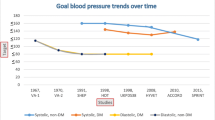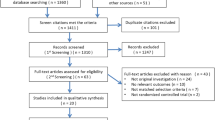Abstract
BP treatment thresholds/targets determine when to initiate treatment and to what level BP should be reduced. The Seventh Joint National Committee on Prevention, Detection, Evaluation, and Treatment of High Blood Pressure (JNC-7) recommended a target of <140/90 for most patients and a target <130/80 mmHg for patients with diabetes or chronic kidney disease. Subsequently, meta-analyses, retrospective studies relating on-treatment BP to clinical outcomes and two large, randomized clinical trials (RCTs) have re-evaluated BP targets. In Action to Control Cardiovascular Risk in Diabetes (ACCORD), a systolic blood pressure (SBP) <120 mmHg was found not to be superior to SBP <140 mmHg in diabetics. In SPRINT (Systolic Blood Pressure Intervention Trial) which studied a different population, the lower target resulted in a 25% cardiovascular event reduction. Despite unresolved issues, certain recommendations can be made with confidence. SBP >160 mmHg should, with rare exceptions, be treated. The historical threshold/target of 140/90 mmHg remains reasonable in most patients in identifying “treatable” risk, i.e., risk high enough to justify treatment and for which available treatment is effective enough to result in significant endpoint reduction. Above 140/90 mmHg, most low-to-moderate risk people should be treated and this target is also appropriate for the majority of high-risk individuals with diabetes, CKD, and/or CAD. The advisability of initiating or intensifying treatment with BPs in the 130s remains equivocal. The next steps in the search for more precise BP targets should include (1) standardization of BP measurement techniques and (2) well-designed RCTs evaluating a treatment target of SBP <130 in carefully categorized patient populations.

Similar content being viewed by others
References
Papers of particular interest, published recently, have been highlighted as: • Of importance •• Of major importance
Hay J. The significance of a raised blood pressure. BMJ. 1931;ii:43–7.
Kannel WB, Dawber TR, Kagan A, et al. Factors of risk in the development of coronary heart disease—six-year follow-up experience. Ann Intern Med. 1961;55:33.
Stamler J, Stamler R, Neaton JD. Blood pressure, systolic and diastolic, and cardiovascular risks. US population data. Arch Intern Med. 1993;153:598.
•• The ACCORD Study Group. Effects of intensive blood pressure control in patients with diabetes mellitus. N Engl J Med. 2010;362:1575–85. Landmark trial comparing SBP targets of 120 and 140 mmHg in diabetics with baseline SBP >130 mmHg.
•• The SPRINT Research Group. A randomized trial of intensive versus standard blood-pressure control. N Engl J Med. 2015;373:2103–16. Landmark trial comparing SBP targets of 120 and 140 mmHg in subjects at high CV risk and SBP >130 mmHg.
Pickering TG. Blood pressure measurement. In: Lip GH, Hall JE, editors. Comprehensive Hypertension. Philadelphia: Mosby; 2007.
Krause T, Lovibond K, Caulfield M, et al. Management of hypertension: summary of NICE guidance. BMJ. 2011;343:d4891.
Lewington S, Clarke R, Qizilbash N, et al. Age-specific relevance of usual blood pressure to vascular mortality: a meta-analysis of individual data for one million adults in 61 prospective studies. Lancet. 2002;360:1903–13.
Chobanian AV, Bakris GL, Black HR, et al. The seventh report of the Joint National Committee on Prevention, Detection, Evaluation, and Treatment of High Blood Pressure: the JNC 7 report. JAMA. 2003;289:2560–72.
Committee G. European Society of Hypertension-European Society of Cardiology guidelines for the management of arterial hypertension. J Hypertens. 2003;2003(21):1011–53.
Williams B, Poulter NR, Brown MJ, et al. British Hypertension Society guidelines for hypertension management 2004 (BHS-IV):summary. BMJ. 2004;328:634–40.
UK Prospective Diabetes Study Group. Tight blood pressure control and risk of macrovascular and microvascular complications in type 2 diabetes: UKPDS 38. BMJ. 1998;317:703.
Hansson L, Zanchetti A, Carruthers SG, et al. Effects of intensive blood pressure lowering and low-dose aspirin in patients with hypertension: principal results of the Hypertension Optimal Treatment (HOT) randomised trial. Lancet. 1998;351:1755–62.
• Xie X, Atkins E, Lv J, et al. Effects of intensive blood pressure lowering on cardiovascular and renal outcomes: updated systematic review and meta-analysis. Lancet. 2016;387:435–43. Extensive meta-analysis of RCTs examining the effects of more vs. less intensive regimens of BP reduction.
Cooper-DeHoff RM, Gong Y, Handberg EM, et al. Tight blood pressure control and cardiovascular outcomes among hypertensive patients with diabetes and coronary artery disease. JAMA. 2010;304:61–8.
Bangelore S, Kumar S, Iryna L, et al. Blood pressure targets in subjects with type 2 diabetes mellitus/impaired fasting glucose. Circulation. 2011;123:2799–810.
Emdin CA, Rahimi K, Neal B, et al. Blood pressure lowering in type 2 diabetes: a systemic review and meta-analysis. JAMA. 2015;313:603–15.
• James PA, Oparil S, Carter BL, et al. 2014 evidence-based guideline for the management of high blood pressure in adults: report from the panel members appointed to the Eighth Joint National Committee (JNC8). JAMA. 2014;311:507–20. Recent American guidelines based upon examination of the results of prospective clinical trials and other important considerations.
Mancia G, Fagard R, Narkiewicz K, et al. 2013 ESH/ESC guidelines for the management of arterial hypertension: the Task Force for the Management of Arterial Hypertension of the European Society of Hypertension (ESH) and the European Society of Cardiology (ESC). Eur Heart J. 2013;34:2159–219.
Bangalore S, Messerli FH, Wun C, et al. J-curve revisited: an analysis of blood pressure and cardiovascular events in the Treating to New Targets (TNT) Trial. Eur Heart J. 2010;31:2897–908.
Chobanian AV. Time to reassess blood-pressure goals. N Engl J Med. 2015;373:2093–5.
Hackam DG, Quinn RR, Ravani P, et al. The 2013 Canadian Hypertension Education Program (CHEP) recommendations for blood pressure measurement, diagnosis, assessment of risk, prevention, and treatment of hypertension. Can J Card. 2013;29:528–42.
Wright JT, Bakris G, Greene T, et al. Effect of blood pressure lowering and antihypertensive drug class on progression of hypertensive kidney disease: results from the AASK Trial. JAMA. 2002;288:2421–31.
Upadhyay A, Earley A, Haynes SM, Uhlig K. Systematic review: blood pressure target in chronic kidney disease and proteinuria as an effect modifier. Ann Intern Med. 2011;154:541–8.
Staessen JA, Gasowski J, Wang JG, et al. Risks of untreated and treated isolated systolic hypertension in the elderly: meta-analysis of outcome trials. Lancet. 2000;355:865–72.
Beckett NS, Peter R, Fletcher AE, et al. Treatment of hypertension in patients 80 years of age or older. N Engl J Med. 2008;358:1887–98.
SHEP Cooperative Research Group. Prevention of stroke by antihypertensive drug treatment in older persons with isolated systolic hypertension. JAMA. 1991;265:3255–64.
Staessen JA, Fagard R, Thijs L, et al. Randomised double-blind comparison of placebo and active treatment for older patients with isolated systolic hypertension. Lancet. 1997;350:757–64.
Mancia G, Laurent S, Agaiti-Rosei E, et al. Reappraisal of European guidelines on hypertension management: a European Society of Hypertension Task Force document. J Hypertens. 2009;27:2121–58.
Wright JT, Fine LJ, Lackland DT, et al. Evidence supporting a systolic blood pressure goal of less than 150 mmHg in patients aged 60 or older: the minority view. Ann Intern Med. 2014;160:499–503.
Bangalore S, Gong Y, Cooper-DeHoff RM, et al. 2014 Eighth Joint National Committee panel recommendation for blood pressure targets revisited: results from the INVEST study. J Am Coll Cardiol. 2014;64:784–93.
Bress AP, Tanner RM, Hess R, Colantonio LD, Shimbo D, Muntner P. Generalizability of SPRINT results to the US adult population. J Am Coll Cardiol. 2016;67:463–72.
McCormick BB, Hiremath S, Ruzicka M. Comment in: a randomized trial of intensive vs. standard blood-pressure control. N Engl J Med. 2016;374
Mariampillai JE, Eskas PA, Heimark S, et al. A case for less intensive blood pressure control: it matters to achieve target blood pressure early and sustained below 140/90 mmHg. Prog Cardiovasc Dis. 2016;59:209–18.
• Yusuf S, Lonn E. The SPRINT and the HOPE-3 trial in the context of other blood pressure-lowering trials. JAMA Cardiol. 2016;1:857–8. Elegant discussion of the results of recent landmark trials evaluating BP targets.
•• Lonn EM, Bosch J, Lopez-Jaramillo P, et al. Blood pressure lowering in intermediate-risk persons without cardiovascular disease. N Engl J Med. 2016;374:2009–20. Large RCT examining prophylactic antihypertensive therapy in patients at intermediate cardiovascular risk.
Messerli FH, Mancia G, Conti CR, et al. Dogma disputed: can aggressively lowering blood pressure in hypertensive patients with coronary artery disease be dangerous? Ann Intern Med. 2006;144:884–93.
Kjeldsen SE, Berge E, Bangalore S, et al. No evidence for a J-shaped curve in treated hypertensive patients with increased cardiovascular risk: the VALUE trial. Blood Press. 2016;25:83–92.
Author information
Authors and Affiliations
Corresponding author
Ethics declarations
Conflict of Interest
The author has been a consultant to Servier and Allergen, an investigator for Allergen, and a speaker for Servier, Glenmark (India), and Pfizer (India).
Human and Animal Rights and Informed Consent
This article does not contain any studies with human or animal subjects performed by any of the authors.
Additional information
This article is part of the Topical Collection on Blood Pressure Monitoring and Management
Rights and permissions
About this article
Cite this article
Gradman, A.H. The Elusive Search for Optimal Blood Pressure Targets. Curr Hypertens Rep 19, 63 (2017). https://doi.org/10.1007/s11906-017-0758-6
Published:
DOI: https://doi.org/10.1007/s11906-017-0758-6




